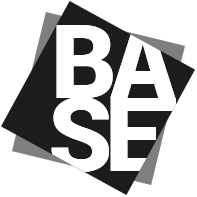IT'S NEVER TOO
LATE TO LEARN
June 26th 2025:
How Forensic Engineering works (or doesn’t work) within the legal process
Engineer Dr Peter Hart outlined eight cases he has been involved in and which ended up going the full distance to Court.

He described the forensic and legal processes that applied for each and considered how these processes could have been improved.
The matters included:
1. Investigation to inform a Coronial inquest into a death in an underground mine.
2. Investigation to inform a Coronial inquest into an electrocution
3. International Tribunal inquiry into a dispute concerning construction of an iron-ore mine.
4. Investigation into a fatal truck crash.
5. Fire in domestic whitegoods equipment.
6. Cause of a car fire.
7. Workcover prosecution involving a load clash with a bridge during transportation.
8. Fire in a vessel undergoing refurbishment.
Dr. Peter Hart's presentation offered FESA members crucial insights into the often-fraught relationship between forensic engineering, the Australian legal system, the coronial process, and insurance entities, asserting that the existing system is in profound need of "urgent repair and reform". He detailed systemic inefficiencies, such as protracted legal proceedings for workplace deaths, the catastrophic consequences of poor initial forensics, and the "unfocused nature of legal arm wrestling" through "he said, she said" expert reports. Dr. Hart also highlighted significant challenges for expert witnesses, including pressure to compromise their independence, the introduction of "ambush evidence" at trial, and the industry's failure to implement critical safety changes despite clear evidence of hazards. To address these issues, he proposed radical reforms, advocating for "better initial forensics" with meticulous documentation, parliamentary time expectations applied to legal processes, standardised reporting formats, and most notably, the exclusive use of "conclave reports" in court to focus discussions and streamline proceedings. His call to action for FESA members underscores the importance of unwavering expert independence, upholding their primary duty to the court, and championing these reforms to achieve a more efficient, just, and safer system for all Australians.
Access to the video recording of this presentation has been emailed to members.





Members have been provided by email with a link to a recording of the presentation, and a podcast.
-------------------------------------
May 29th: lawyer Bronwyn Weir spoke on building insurance reforms, and a cladding update. Her 43 minute recorded Zoom presentation with slides, and its link, have gone by email to financial members, as well as a link to an excellent podcast (highly recommended - listen in your car) of Bronwyn's address.
Navigating Reform and Understanding Defects
Patrick Irwin introduced Bronwyn, highlighting her extensive experience and noting that she had spoken to the group twice before. Her ability to provide a broad, global, and regulatory perspective on the construction industry was noted. Bronwyn is the Managing Director of Weir Legal and Consulting, a role she has held since 2017. She specialises in advising government regulators, with her expertise in building regulation. In 2017, she co-authored the influential Building Confidence Report with Professor Peter Shergold. She continues to advise Australian governments on crucial building regulatory matters, including combustible cladding, security of payment, regulating developers, building and materials defects, and enforcement powers. Her advisory work extends beyond construction to sectors including education, health, and water.
Key Topics:
The presentation was structured around two distinct, related key topics. Bronwyn paused between the two sections for questions.
The two key topics were:
1- The move to first resort insurance in Victoria.
2- Research published by Cladding Safety Victoria (CSV).
Do join us, and get the benefits of members' knowledge, presentation details, contacts and discounts to events.
------------------------------------------------------------
May 1st - Auburn Hotel - Geoff Fletcher spoke on
Compliance, Conformance, Certification, Consultant criminality and the Engineering Code of Practice.
The presentation addressed the critical aspects of regulatory compliance and certification
for professional engineers in Australia. It draws on recent legal cases and
regulatory shifts, with a focus on the building and construction sector.
Here are some key points from the presentation:
· Focus on Regulatory Compliance: Certification is about confirming compliance with regulations, not just client expectations or Australian Standards, unless those standards are specifically referenced in the regulations.
· Australian Consumer Law (ACL): The presentation highlights the importance of the ACL, particularly Section 18 regarding misleading and deceptive conduct, which can apply to engineers even without a direct contract with the affected party.
· Compliance vs. Conformance: Compliance means adhering to regulations, while conformance is about matching design to construction. Both are important, and they are distinct.
· Regulatory Certification: Certification is about complying with building regulations and the National Construction Code (NCC), not just Australian Standards, unless specifically stated.
· Legal Cases: The presentation discusses cases like Mistrina v. Australian Consulting Engineers (ACE) and Actron v. DEEQ Consulting, which illustrate the serious consequences of defective certification and the engineer's responsibility for regulatory compliance.
· Personal Risk and PI Insurance: Engineers face significant personal and professional risks, and Professional Indemnity (PI) insurance may not cover intentional wrongdoing or criminal acts.
· Importance of Being Informed: Engineers must actively seek out and understand relevant regulations, acts, and court judgments.
· Key Takeaway: Regulatory certification is about demonstrating compliance with the law (regulations and the NCC), and when an engineer certifies, they claim to comply, and others have a right to rely on that certification.
In essence, the presentation emphasized the shift towards stricter enforcement and accountability for engineers, stressing the need for diligence in understanding and applying regulations.



Listen to the podcast here.
You can watch the presentation here (two parts - 38 minutes, then 23 minutes):
---------------------------------------
FESA Zoom Meeting on Lightning Strike and Power Surge Events - 27th March 2025
Presenter: Grant Gatland, Committee Member (Envista Forensics Electrical / Mechanical investigation team). Lightning strike and power surge events, differentiation, damage assessment, and implications for insurance claims.
Executive Summary:
This briefing document summarises the key themes and information presented by Grant Gatland during a FESA Zoom meeting focused on lightning strike and power surge events. The presentation aimed to educate FESA members on the differences between these events, the types of damage they cause, methods for validating claims, common myths, and the complexities involved in assessing related losses. Gatland drew upon his extensive experience in investigating technical loss events for the insurance industry. A significant emphasis was placed on identifying genuine lightning or power surge damage versus alternative causes, including potential fraudulent claims.
Key Themes and Important Ideas/Facts:
1. Importance for Insurers:
● The primary driver for understanding the nuances between lightning strikes and power surges is for accurate validation of insurance claims.
● Distinguishing the cause of damage is crucial for determining policy coverage, as some policies may exclude power surge damage while covering lightning strikes.
● The financial implications can be substantial.
2. Defining Lightning and Power Surges:
● Lightning: Described as a "giant spark" that occurs between charged regions in the atmosphere (clouds, air, and ground). It involves a stepped leader of negative charges meeting a streamer of positive charges from the ground, resulting in a high-current discharge (ranging from 5,000 to 200,000 amps).
● Power Surge: Primarily defined as a "voltage spike" that can be caused by nearby lightning (through inductive coupling) or other events like transformer failures. Gatland clarified that a power surge isn't typically just an increase in current; it requires a voltage increase.
3. Differentiating Damage:
● Lightning Strike (Direct): Causes intense heat and current, potentially leading to physical damage like trees being blown apart, brickwork fracturing, and burn patterns along the current path.
● Validation involves looking for a "path to earth" from the point of impact, although this isn't always obvious.
● "Small pinhole-type damage" can occur on metal objects.
● Power Surge (Inductive Coupling from Lightning): Large magnetic fields produced by a nearby lightning strike can "inductively transfer energy and induce voltages into other conductors," particularly long runs of low-voltage wiring (e.g., telecommunications, security systems).
● Damage often manifests as a failure of connected equipment due to high voltage spikes, potentially affecting multiple devices but not always.
● A key indicator is damage not originating from the power supply side of the circuit but directly impacting the low-voltage wiring.
● Physical burning damage is less common; instead, components like chips may "blow apart" without prior heating marks.
● Power Surge (Other Causes): While the presentation focused on lightning-induced surges, Gatland briefly mentioned transformer failures as another potential cause, typically resulting in a sustained voltage increase rather than a rapid spike.
4. Common Myths Debunked:
● "Lightning will always cause a circuit breaker to trip."
● "Lightning will always leave a boom hack behind on electronic components."
● "If one item's damaged and others are saved, then it should be a power surge rather than lightning."
● "Lightning doesn't strike twice." (Gatland highlighted Kuala Lumpur International Tower as a location frequently struck).
● "Equipment damaged by lightning so it can't be repaired or if it is repaired, it won't be reliable."
● "Impossible to distinguish between lightning and power sage."
5. Latent Damage:
The concept of latent damage from lightning (failure occurring weeks or months after an event with no immediate signs) is generally not supported by Gatland's experience.
If damage is going to occur, it "usually will develop within a matter of days and not outside about a month or so."
6. Equipment Vulnerability:
● Network and telecommunications equipment, AC equipment on rooftops, long-running low-voltage cables, fire alarm systems, elevators, and security camera/card access systems are particularly vulnerable to both direct lightning strikes and inductively coupled power surges.
● Power supplies often have built-in protection (Metal Oxide Varistors - MOVs) against typical power surges but may not withstand direct or severe lightning-induced surges.
● High-voltage power transmission networks have lightning arrestors to protect their infrastructure.
7. Prevention and Protection:
● Lightning protection systems (lightning rods, earthing) are primarily designed to prevent structural damage to buildings by providing a path to the ground. They may not prevent damage to internal equipment from induced surges.
● Surge protectors at the power supply level can offer protection against voltage increases and milder power surges but may not be effective against extreme lightning-induced spikes.
● Building grounding systems (multiple earth neutral - MEN) are primarily for safety (tripping circuit breakers in fault conditions) and not for diverting lightning strikes.
8. Fraudulent Claims:
● Gatland presented case studies illustrating potential fraudulent claim attempts, where damage appeared to be caused by deliberate heat application (e.g., with a cigarette lighter) to mimic electrical failure rather than a lightning or power surge event.
● Close examination of damage patterns, such as the melting of plastic components without corresponding electrical failure indicators, can raise suspicion.
9. Tools for Validation:
● Online lightning detection services (Gatland mentioned TOA as a provider) can provide historical data on lightning strikes in a specific area, helping to verify if a lightning event occurred at the claimed time and location.
● Analysis of the proximity and intensity of recorded strikes is crucial in assessing the plausibility of a lightning-related claim.
Quotes:
● "A power surge is really another word for a voltage spike." - Grant Gatland clarifying the definition of a power surge.
● "Latent damage from lightning - It's seldom something that occurs and what we find is that if it is going to occur, it usually will develop within a matter of days and not outside about a month or so." - Grant Gatland on the improbability of long-term latent damage.
Conclusion:
The presentation provided valuable insights for engineers dealing with lightning strikes and power surge events. He effectively differentiated between the causes and types of damage associated with each, highlighted common misconceptions, and emphasised the importance of thorough investigation and the use of available tools for investigation. The discussion also touched upon the potential for fraudulent claims, urging vigilance in assessing damage patterns. Understanding these distinctions is critical for accurate assessment to ensure the proper outcomes for both insurers and policyholders.
February 20 2025: two presentations on truck accidents and design shortcomings
30 members and guests had the benefit of two very good presentations at the Auburn Hotel, Hawthorn.
Here are links to the addresses:
Raph Grzbieta on a fatal multi-vehicle accident at Dubbo
Peter Hart on several design flaws in truck design, mirrors and speed limit advice.
The presentations are 45 and 50 minutes long respectively.
Raph: Peter:
-----------------------------------------------
December 12: Artificial Intelligence
Brett Rutledge gave an excellent presentation on the strengths and pitfalls of Artificial Intelligence, with practical advice on how to use it and what to be very careful about.
You can view the presentation by clicking here. Please be patient while it
Note: The recording is in three parts.
1. (6 minutes) - recording stopped for meal ordering
2. Presentation (56 minutes)
3. Questions and answers (26 minutes).
---------------------------------------------------------
November 14: the Baltimore Bridge Collapse
Dr. Colin Caprani presented on the Baltimore Bridge Disaster, covering key insights on bridge safety, risk management, and lessons learned for asset owners globally.

Dr. Caprani is the Head of Structural Engineering at Monash University. He is a Registered Professional Engineer, and a Chartered Structural Engineer (CEng FIStructE). He is also the Chair of CROSS-AUS and the Australian Regional Group of the Institution of Structural Engineers. With extensive expertise in bridge safety and performance, his research focuses on bridge traffic loading, vibration serviceability, and structural reliability.
Topics covered included -
- Issues of large ship management
- What happened in Baltimore
- Risk management for ship impact, mainly driven by US and European approaches
- What went wrong in Baltimore
- Lessons for asset owners around the world
A 55 minute recording of the presentation can be viewed here. Passcode (if needed) ZM0we!k@
Colin's Powerpoint slide set (without any commentary) is here: fesa-fsk.pdf
October 24 - injuries to young workers
Engineer Roger Lewis spoke on young workers (under 25 years of age) who are over-represented in serious injuries in the construction and manufacturing sectors, noting that the injury rates to young workers have increased since 2016.

This presentation examined three construction-related case studies, identifying common and systemic causes, and describing inexpensive measures that would likely have prevented the incidents from occurring.
1. Nail gun incident with loss of eye;
2. Circular saw kick-back and amputation:
3. Fall from an unstable work platform.
Using the lessons from the case studies, a strategy was presented to help unravel the full circumstances of a young worker’s injury. It emphasises identifying gaps in training, supervision, tool selection and systems of work – and how a prudent employer of young workers should diligently control the higher risks faced by such workers.
Recording of Roger's address (35 min) is here: https://photos.app.goo.gl/7dG7XrV7VDu4Zb9JA
-------------------------------------------------------------
September 2024: Risks facing children - and what design changes are needed.Gail Greatorex has a passion for product safety and good product design. For 25 years she worked in consumer product safety with the Australian Government, mainly at the Australian Competition and Consumer Commission.

Product safety can be a complex field, especially where standards and regulations are involved. Gail believes there are great benefits in people working together and supporting one another to make our lives simpler. Designing a product well from the start will make sure it’s as user-friendly and as safe as it can be. Her website (www.productsafetysolutions.com.au) provides guidance and examples of all these things.
Gail's presentation is available here.
You will need this passcode: +5z^Re8u
-----------------------------------------------------------------------------
26 August 2024:
Rescue of 41 Indian miners
Prof Arnold Dix ("scientist, lawyer and tunnel guy") gave a fabulous presentation at the Auburn Hotel Hawthorn of this extraordinary rescue, seen around the world in 2023. The presentation was hugely informative, entertaining and encouraging. Arnold is President of the International Tunnelling and Underground Space Association – representing the interests of more than 100,000 global subject matter experts and 81 Member nations as the world’s peak Underground NGO to the United Nations.

Arnold outlined the basics of tunnel rescues generally, the behaviour of mountains, and spoke persuasively on important non-technical attitudes and behaviours appropriate to engineers working on any problem involving other people. He urged us as engineers to "Get out and talk to the people affected", " Just DO IT, don't hang back"; "focus on the problem - put all other noise aside"; and in particular, to "be aware of and carefully consider your instincts" - ie treat seriously the wisdom, "sensing" and experience that you feel, apart from your rational deductions. (Session recording details: see below)


Arnold is a great communicator - a man who humbly links his redoubtable skills as an engineer, barrister and geologist with practical attitudes that inform his work, his hobbies and numerous activities. For example, in relation to working on a rescue or a similar problem with others, he said -
Things are never like it is in the movies
Everyone is clever in retrospect
You never have enough information to make a perfect decision
No “one” person saves anyone – it Is always a team
Things always take much longer than expected (even if you expected it would take longer)
You always have to make do with what you’ve got
Information includes “instinct”
Learn lessons – be humble.
This was one of our best sessions yet.
Session recording: a recording in four parts (totalling about 78 minutes, with plenty of of TV and other clips) is here: on the FESA members-only page ( - follow that link - the page is configured to restrict access to financial members, who are entitled to recordings). Please raise any questions about your membership status with Sara Abbasi.
25 July 2024: Artificial intelligence
FESA member Kelvin Genn gave a very informative Zoom presentation to a large gathering .
Using practical examples, Kelvin demonstrated how artificial intelligence (AI) is rapidly transforming the way experts conduct inquiry and research. Key topics covered were analysing unstructured data; intelligent information retrieval; knowledge state assessment; and enhancing collaboration and communication. An outstanding topic and presentation.
A recording (50 minutes) of Kelvin's presentation is here
Passcode if needed: J%%8Z@7v
20 June 2024: Legal changes affecting building practitioners and engineers
55 people attended a highly informative presentation by lawyer Bronwyn Weir, a leading authority on building regulation nationally, and an advisor to government regulators. In 2017 she co-authored the Building Confidence Report (Google it) with Prof Peter Shergold; it remains an influential report on policy development.

Bronwyn advises on building regulatory matters including the impact of combustible cladding, security of payment, regulating developers, apartment defects, product safety and the exercise of enforcement powers.
She presented a highly informative account of the emerging engineers' registration schemes, state by state, and the new property developer accountability scheme in the ACT. She dealt with key features of the NSW Engineers' Practice Standard which will take effect in September 2024. Finally, she updated us on her second case study for the NSW Building Commissioner, Broken Promises, Blame Games, balconies.
Bronwyn's Powerpoint set is now available (click here). This brings up the front page. You may need to click the little icon at the left of "Page 1 of 21" to start it.
The recorded presentation (of 75 minutes) has also been posted on Youtube, in 4 consecutive segments (of 11, 30, 16 and 29 minutes). Go to youtube.com and search for FESA June 24. Scroll down and you will find FESA 24 Bronwyn Weir 1 of 4. Start there.
An apology: issues at the venue (one non-working screen, a flat microphone) made recording difficult, and we could not put Bronwyn's Powerpoint up simultaneously with her address. No great matter).
Lots of networking and conviviality made this a great night:





Next month: a Zoom meeting, then in August, a presentation at the Hawthorn pub dinner by Prof Arnold Dix. a very interesting and creative problem solver who was recently centrally involved in the rescue of miners in India.
------------------------------------------------
18 April 2024: expert evidence
Dr Ian Freckelton AO KC gave a great talk at the Auburn Hotel on expert evidence, specifically on how to be a great expert witness. He covered forensic investigations, report writing, court attendance, giving evidence, judges' vagaries, and how to get things wrong. Many entertaining anecdotes illustrated the address.
Dr Freckelton is the leading legal expert on this subject. He is the author of the Australian leading legal volume ‘Expert Evidence’ (which is in its seventh edition). His ‘day-job’ is as a practicing senior barrister. 



22 March 2024
An excellent Zoom presentation by Hannah Prouse on a 16-tonne mobile crane rollover.


34 people participated - Hannah explained the causes, the general effects of wind, boom extension and relevant principles of stability. Codes and regulatory gaps were addressed. It was a very good coverage of cranes generally. The full recording (43 minutes) is available here - you may need this Passcode (copy it in case): HaM3N+C?
22 February 2024
A full house (42) at the Auburn Hotel, Hawthorn, for convivial drinks, welcomes to several first-time guests, a good dinner, and excellent presentations from Bill Gleeson on the Lithium Ion Big Battery fire in Victoria, and Peter Freere on Wind Turbines - how their performances differ and why they are hard to test.
Recordings are available via the links below, after these photos.
Your Committee spent a convivial hour and a half before the meeting, discussing many things:
L to R: President Geoff Fletcher, Vice President David Lake, webmaster Mark Dohrmann, Secretary and Past President Patrick Irwin, Grant Gatland (who flew from Adelaide), Peter Hart, Kelvin Genn and Treasurer Margarita Vargas (who drove to Melbourne from Wagga this same day).
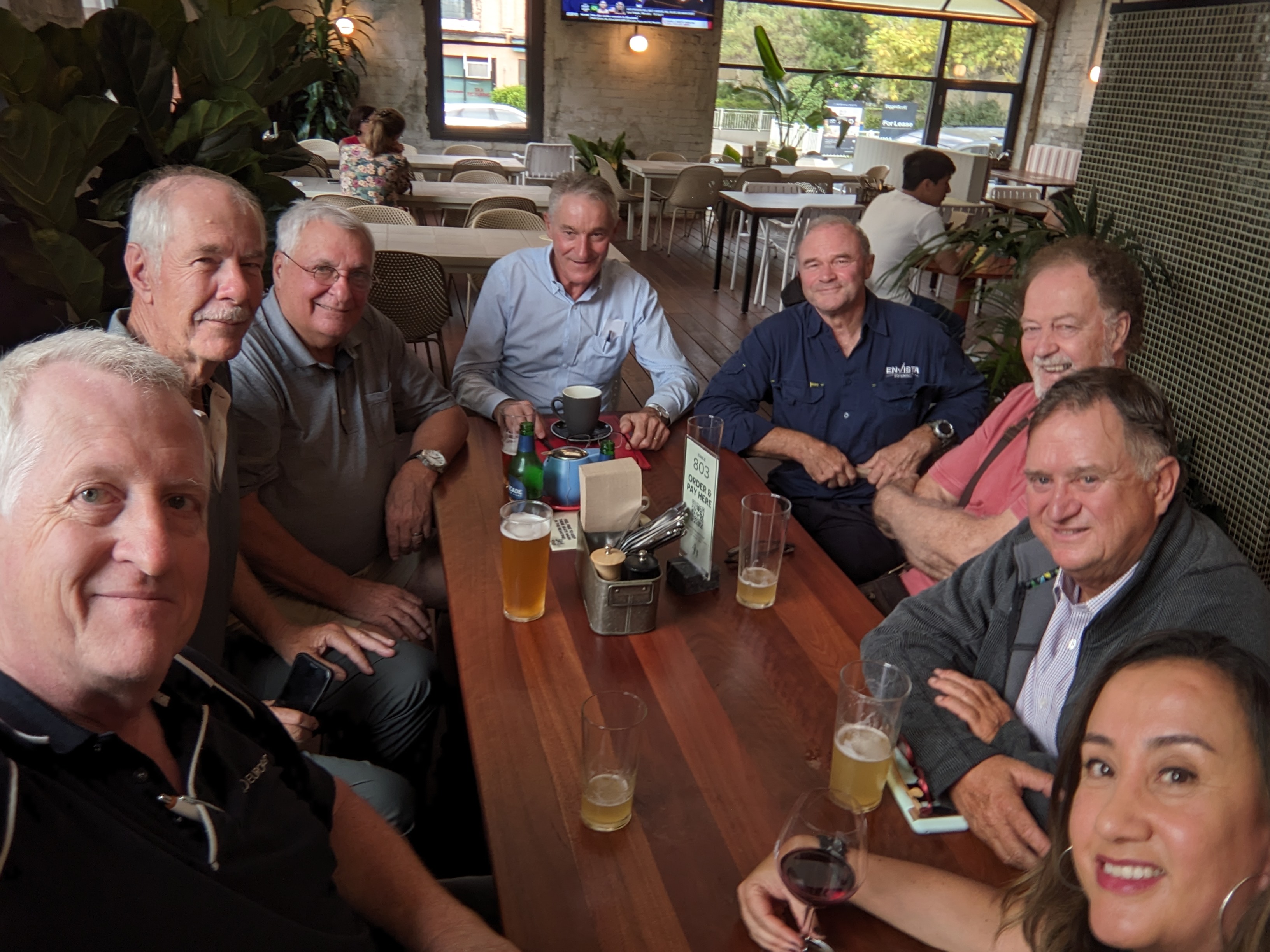
Dr Peter Freere opened the batting:
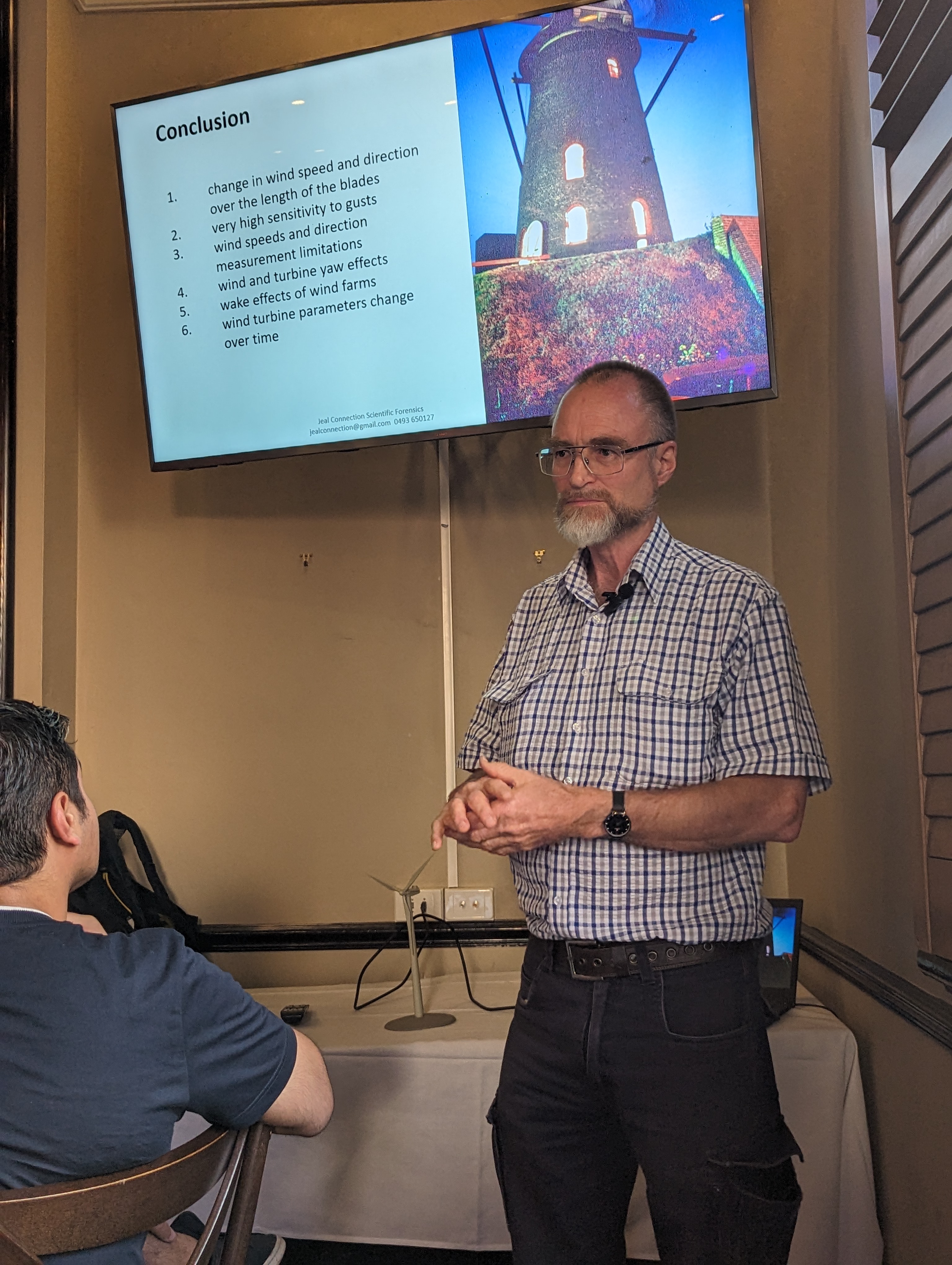
Margarita Vargas (Treasurer) and Patrick Irwin (Past President, now Secretary) - President Geoff Fletcher behind: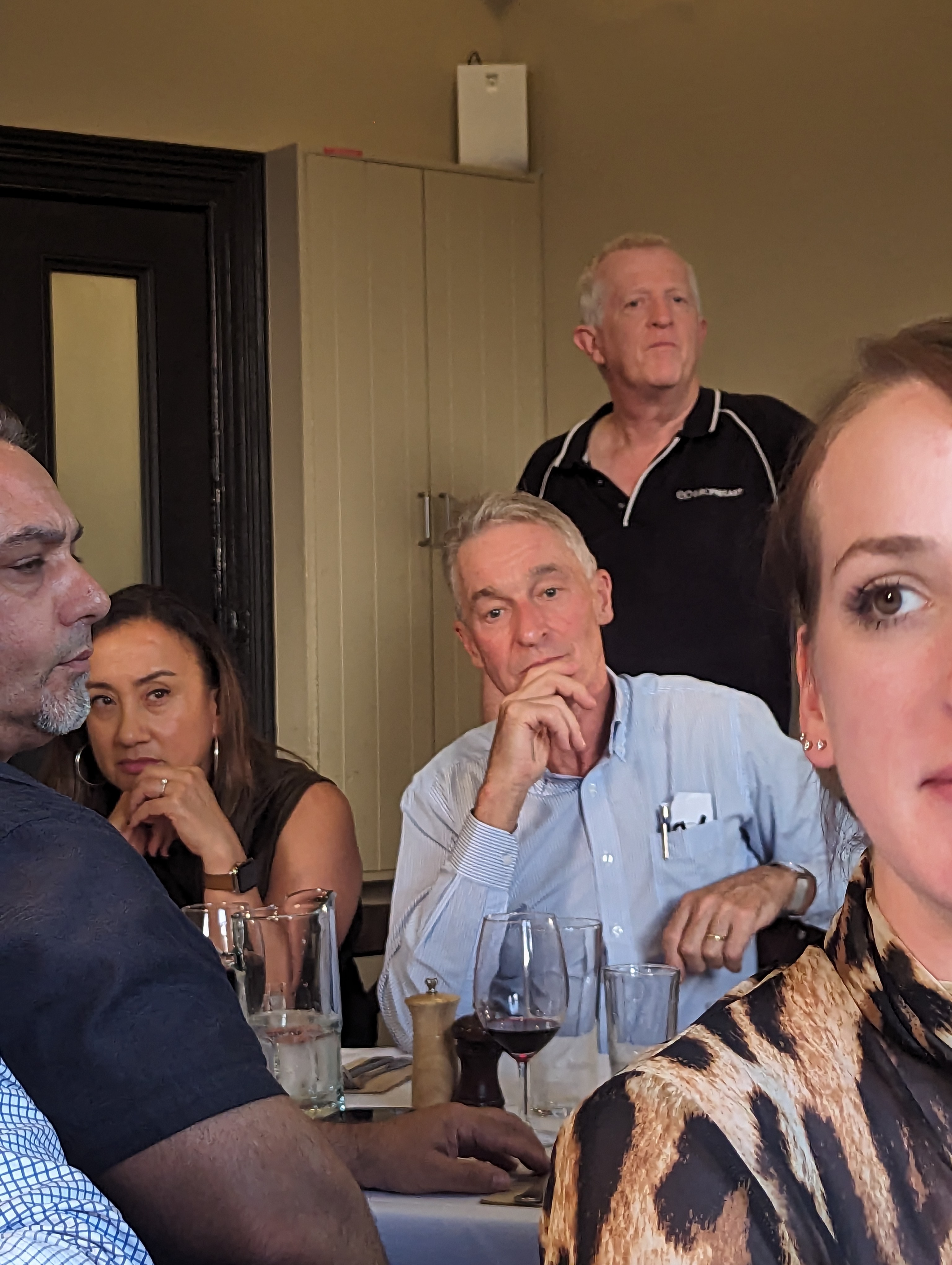
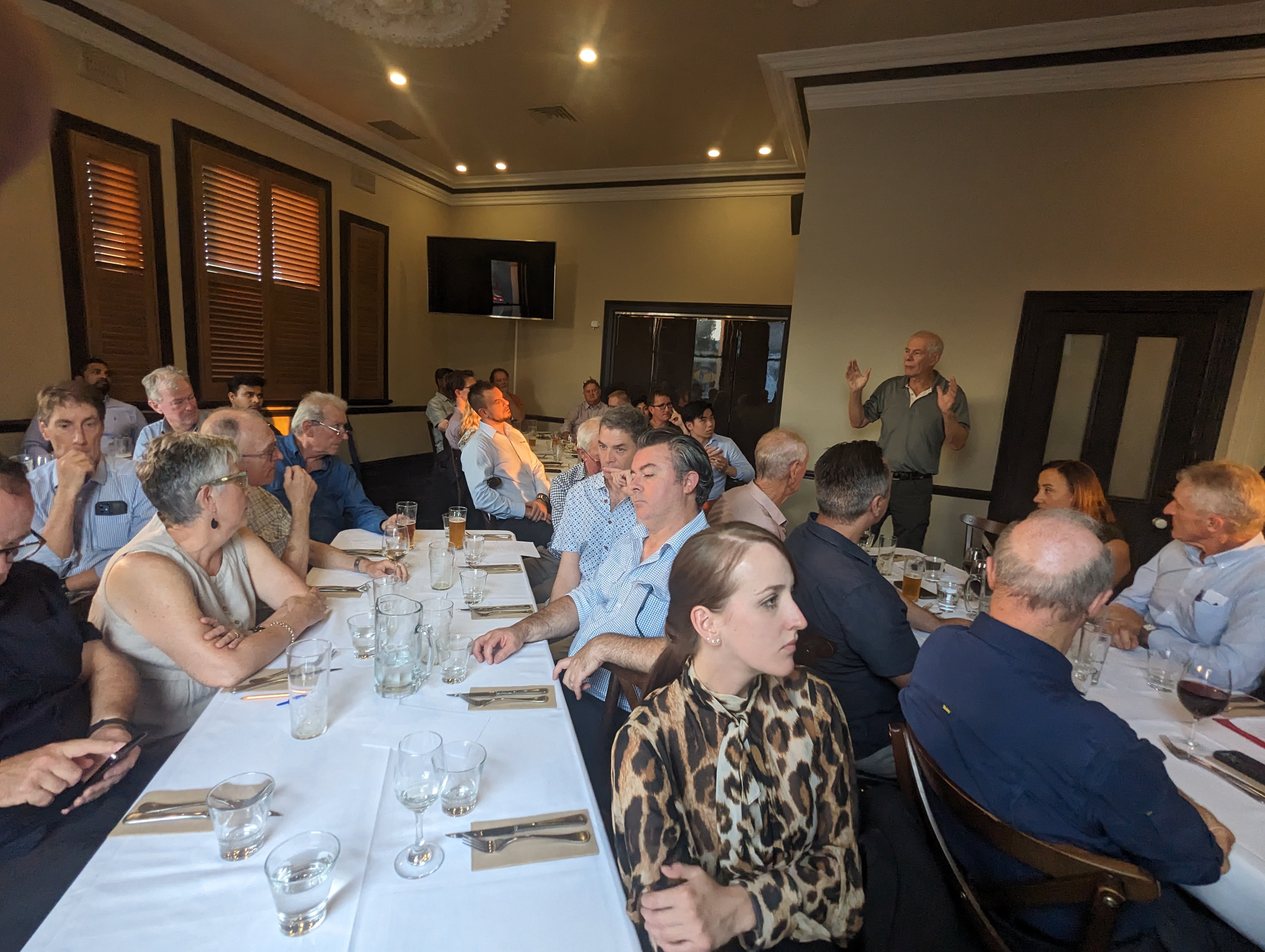
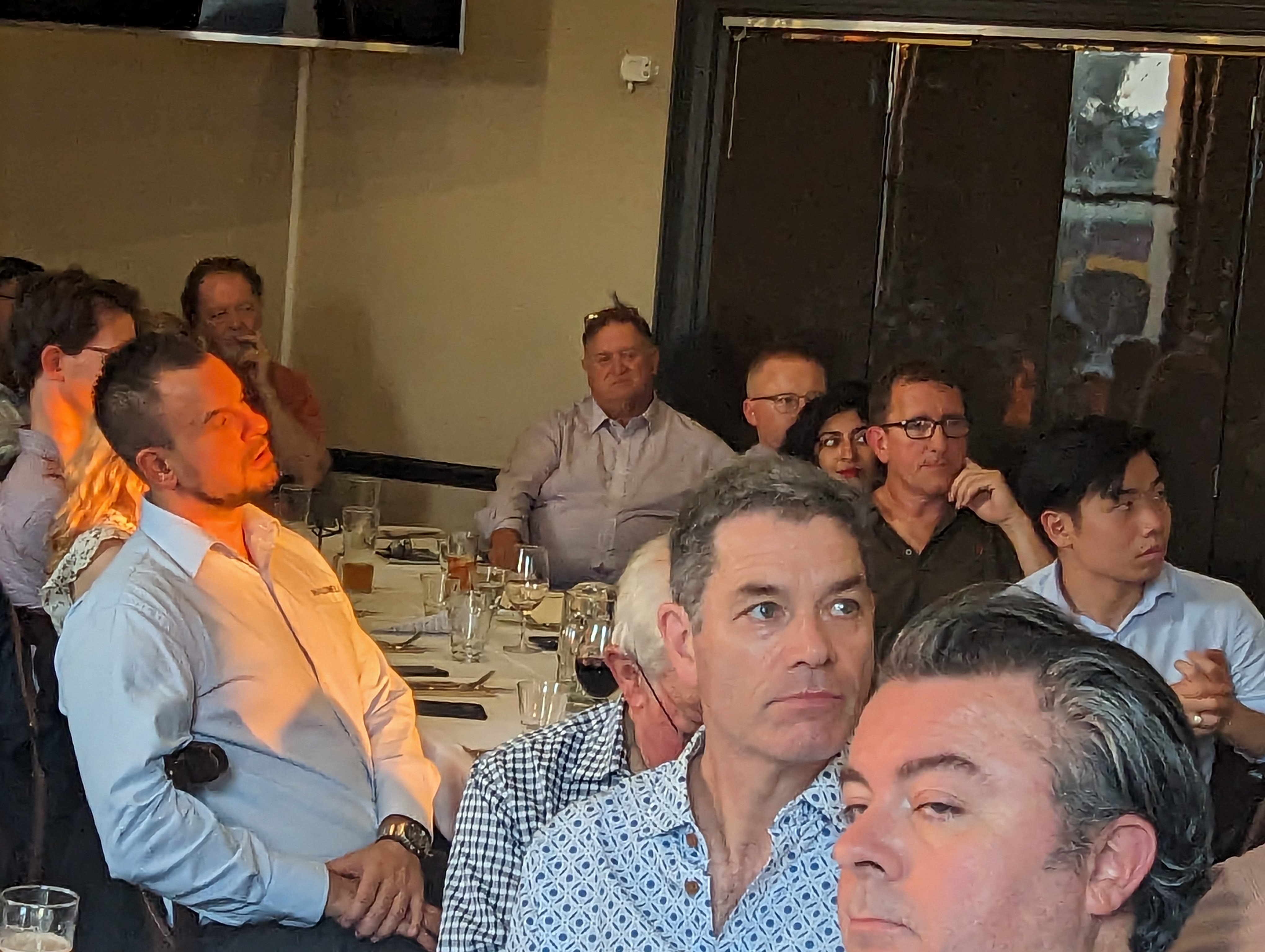

Do listen to and watch our two presentations via these Dropbox links.
Amateur recording now has good audio with a new wireless mike, and we're working on local lighting to adjust contrast:
Peter Freere on Wind Turbine Testing (20 minutes) - watch it here
Bill Gleeson on the Lithium Ion Big Battery fire (38 minutes) - watch it here
The March meeting (Thursday 21) will be on Zoom.
We have some fabulous speakers who have agreed to present to us this year. All will be revealed. No, not Taylor Swift.
-------------------------------------------------------------------------------------------------------------------------------------------------------------------
23 November 2023: electrical switchboards fires and faults
A recording of the FESA Zoom presentation from last Thursday November 23 on "Electrical Switchboards - fires and faults" by Peter Hart and Martin Mulcahy is available here. Note: you will need to copy then enter this passcode to play the recording: +8+Jb+pv
October 2023 - building collapse and lessons for engineers
FESA member Geoff Fletcher spoke on the 2013 collapse of a multi-storey building in Dhaka, Bangladesh. 34 members and guests were present at this interesting talk, which was preceded by our AGM.

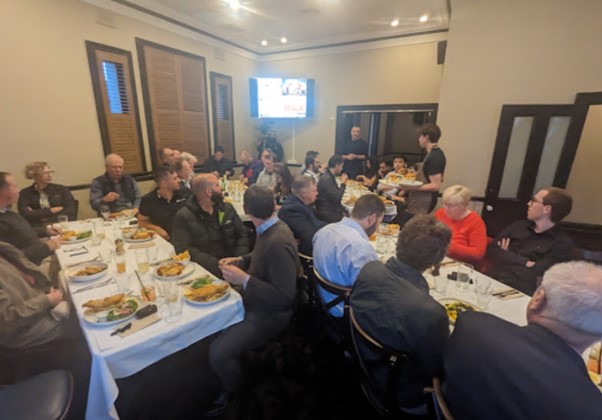

The collapse killed over 1,100 people and injured some 2,500. It is claimed to be the deadliest accidental structural failure in modern history. Geoff, an engineer, outlined incompetence, shortcuts, greed, lack of review, and third world low-paid garment manufacture factory stacking, But just what does "accidental" mean? Numerous people faced murder charges as a result, from a litany of failures - negligence, recklessness and corruption in administrative, design, construction and operational controls. The public suffered - and their need for engineering competence and ethics (in any discipline) has never been so great!
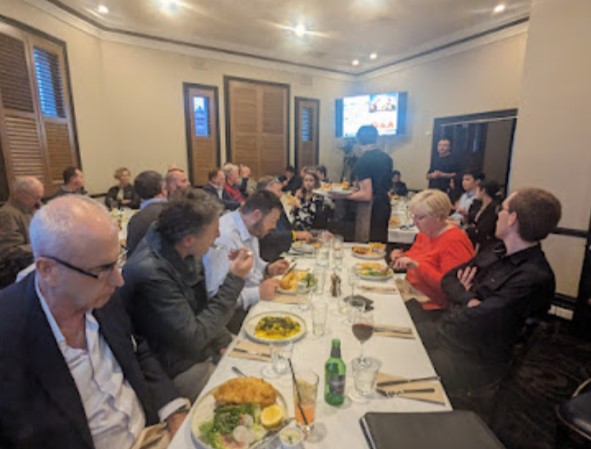
Geoff's main takeaways for ALL engineers were these:
- Check your own character before starting your calculations and computer! Uncompromised ethical standards are always paramount.
- No “something” is better than a bad “something”!
- Be careful with whom you get into bed!
- NEVER fear inspection / verification / 3rd party reviews. Encourage it!
- NEVER progress past an unexplained, unsolved problem.
- You mght get away with breaking the laws of the State, but never the laws of physics.
- You get not what you EXPECT, but what you INSPECT.
- Imagine one day being cross-examined in Court re your actions!
A good evening of networking and a fine meal rounded things out well. The presentation was professionally recorded and is available here now.
-----------------------------------------------------
21 September 2023
Dr Reza Javaherdashti spoke to FESA via Zoom on 21 September (from Croatia) on Microbiologically influenced corrosion (MIC), with a focus on off-shore engineering due to its importance for Australian industry. MIC refers to the influence of micro/ macro-organisms on the kinetics of corrosion processes on metals, caused by adhering to the interfaces (usually referred to as “biofilms”-which, in fact, is a wrong terminology).
The presentation focussed on the necessity of understanding MIC mechanisms as per API 580/581 and how forensic engineering methods may or may not be useful in dealing with failures stemming from MIC mechanisms. During the presentation, some interesting aspects of MIC (such as EMIC) which are very important to interpret high corrosion rates were presented.
Some facts and figures about its importance from a corrosion science and engineering point of view as well as the names of some important bacteria associated with MIC were briefly explained.
A one-hour recording of the presentation is here. If needed, the Passcode is tGb1E^cz
Reza also gave us the following links to Youtube clips, giving further information on the topic:
https://www.youtube.com/watch?v=eCmgrcXJ_8w
https://www.youtube.com/watch?v=fA5Da4GOTnQ
https://www.youtube.com/watch?v=W2YfNbiffs4
https://www.youtube.com/watch?v=wKw85VokBBg
https://www.youtube.com/watch?v=r_zcCaioMyg
https://www.youtube.com/watch?v=tSfgJtUoPUM
https://www.youtube.com/watch?v=z848Cv2Sdm8
---------------------------
24 August 2023
45 people attended a presentation on Waterproofing by Karl Wootton. It was a very informative talk, well illustrated, with practical illustrated examples.
The talk (37 minutes plus 4 minutes introduction) is here. The Q & A session was not recorded by request - candour, confidentiality, etc.





27 July 2023
42 people attended a Zoom presentation by slips, trips and falls expert Richard Bowman, who spoke in helpful detail about surfaces, gait, falls, standards, protocols, expert evidence - with good examples.
His session has been recorded (50 minutes plus Q & A) and is available here:
Passcode if needed: *E?Q%uW522 June 2023
60 members and guests attended to hear barrister Tim Sowden speak helpfully on Effective Expert Evidence. He addressed rules of evidence as they affect experts; things you can, can't or must do; what gives a barrister confidence in an expert; hot tubbing; recent leading cases affecting experts; subpoenas; and numerous interesting questions from the floor.
Tim's Powerpoint slides are here; and separately, here is his 38 minute presentation.
An excellent night of conversation, questions and answers, discussions, networking and as usual, a fine meal and drinks.






27 April 2023:
Engineer Ted Metcalfe delivered a presentation to 30 present on Professionalism, Ethics and Protecting the PublicTed explained the tradition of the Iron Ring and other reasons why professional engineering practice is different in Australia from that in Canada. He presented some of the findings from his study of failure of Complex Engineered Systems, using the Dreamworld Tragedy and the Longford Gas Plant Explosion to illustrate the role of Royal Commissions and Coronial Inquiries in learning for engineers. (It’s usually not engineering incompetence that causes the failure). He went on to describe the recurring role of systemic regulatory failures, the consequences of commercial pressures on engineering outcomes, and gave an overview of the continuing importance of Professionalism and Ethics.
Lively question and discussion spells covered a range of interesting themes.
The session was recorded in two parts. The sound is pretty average, but the screen displays are very clear. Some shaky amateur camera work, too. Just turn up the volume, and you'll get the whole presentation.
Part 2 (also 26 minutes) is here.
----------------------------------------
30 March 2023
Australia’s Regulatory Structure for the Safety of Equipment Supplied to the Market
Jean-Marie Ntahonkiriye, Senior Engineer
Market Intelligence and Enforcement, Energy Safe Victoria (ESV).
and Dr Peter Hart, ATTAR.
This ZOOM presentation was rescheduled to Thursday 30 March (5:30 pm) and described the regulatory structure that applies to equipment that is supplied to the Australian market. It was mainly about Australia’s regulation of low voltage electrical equipment. First, FESA member Peter Hart (below) gave a brief overview of the regulatory structure as it applies to consumer goods, plant equipment, mechanical equipment intended to be installed in buildings and on and off road vehicles.
Peter then introduced Jean-Marie Ntahonkiriye of ESV, who provided a detailed presentation focusing on low voltage electrical equipment.
A recording of the evening is here (cut and paste it into your browser if it fails to link):
Passcode%3A%2520V%243F%236R%26
23 February 2023
The House with No Piers
Lawyer Bronwyn Weir gave a presentation applauded by all 56 present. She spoke passionately about a report she authored for the NSW Building Commissioner, detailing details of the ordeal of a couple who built a home in rural NSW in 2009.

Premature cracking in the walls led them into a initiating a dispute in NCAT which consumed them for almost five years. One of the key issues on which expert evidence was given was whether piers had been constructed as documented in the approved engineering design. The court accepted the builder and his expert engineers’ evidence that the piers had indeed been constructed, and the court found against the owners. They were ordered to pay the builder’s costs which together with their own costs were in excess of $300K. They appealed and lost. As the matter was concluding David Chandler was appointed as the first NSW Building Commissioner. They told him their story and he visited their home, during which time a comprehensive excavation was carried out to show that in fact no piers had ever been constructed. Chandler was determined to shine a light on what had happened to these people and hence the report was commissioned. The system failed these owners. The conduct of some of those involved lacked competency and integrity – a hallmark of the state of Australia building and construction industry.
Bronwyn discussed these during her presentation, providing a snapshot of where building regulatory reforms are at, five years on from the Building Confidence Report. Animated discussion followed, expressing dismay with the system, with the evident incompetence and lack of integrity of some of the lawyers and enginners. The builder was deregistered.
Bronwyn Weir has been a lawyer for 25 years. She runs a small legal practice advising all levels of government on regulatory and compliance matters.
Our 56 guests had a cracking night. Lots of connections.
A recording of the presentation (57 minutes) is available here. Note: the tail end of Bronwyn's talk is in this separate file. Her complete Powerpoint slide presentation is here.
We have also received Basic Expert's presentation by Jonathan Barnett, Jonathan Duler and Oscar Salt on lithium ion batteries and electric car fires.
You can access their presentation slide set here.






24 November 2022: four great presentations, and our AGM
44 members and guests met for convivial drinks at the Auburn Hotel, Hawthorn, Melbourne.


The AGM was then run efficiently over just a few minutes. No elections were due. In his report (here), President Patrick Irwin announced the cessation of the "Corporate" member category, and the benefits to members by replacing it with conventional membership status. The accounts were received and adopted (click here to read them).
Thanks were extended to all office bearers, especially hard-working Secretary Geoff Fletcher, and member Mark Dohrmann, who was presented with FESA Life Membership for his 23 years' continuous service to the Committee on backroom membership management, our website and communications.

Four excellent short presentations followed.
Robust discussion followed each speaker. Click on their name to see their talk - they vary from 8 to 14 minutes.
Peter Hart outlined cases where a truck chassis rail had failed in different ways. Scary! And poor design by major manufacturers.
Nick Jenkins described elevators and the obligations of designers under the Plant Regulations. Getting stuck in a door is problematic, but not illegal.
Patrick Irwin explained the fortuitous discovery of key facts in preparing a building case involving millions of dollars, and what ethical and professional steps needed to be taken to revise his opinion and so assist the court.
John Culvenor warned us about the Government's "free" program offering incandescent light replacement with LEDs. There's no obligation on suppliers to ensure that light levels and quality are retained. Look for lumen equivalence, not wattage.
The usual good hotel menu pleased the throng:





Coffee followed, with much conversation, meetings and getting to know people. A happy and safe Christmas was wished for all members and their families.
--------------------------------------------------------------------------------------------------
27 October 2022: Electric Vehicles - fire safety challenge
Three speakers from Basic Expert presented to 34 members and guests on the global problem of fires in electric vehicles - lithium ion batteries being the cause. Whether charging, driving or just parked, these fires occur. The passage of time increases the degradation of the batteries and the likelihood of spontaneous combustion. Fires cannot be extinguished with water, and create an inflammable vapour cloud. Events are under-reported (there is an average of seven EV fires a day in China) with zero literature, data, guidance, time, or money to do more … this topic is relevant to any practitioner with an interest in risk, engineering failures, or the safety of our built environment…
The speakers - Jonathan Duler, Oscar Salt and Jonathan Barnett - covered the historical context of how EVs have slotted into our built environment and lifestyles, but how badly this has gone wrong, by way of case studies for some particularly severe incidents.
The recording of the presentation (1 hr 10 minutes) is too big to load on to this site, but we hope to soon have a link here to the presenters' slides, and which you can access.
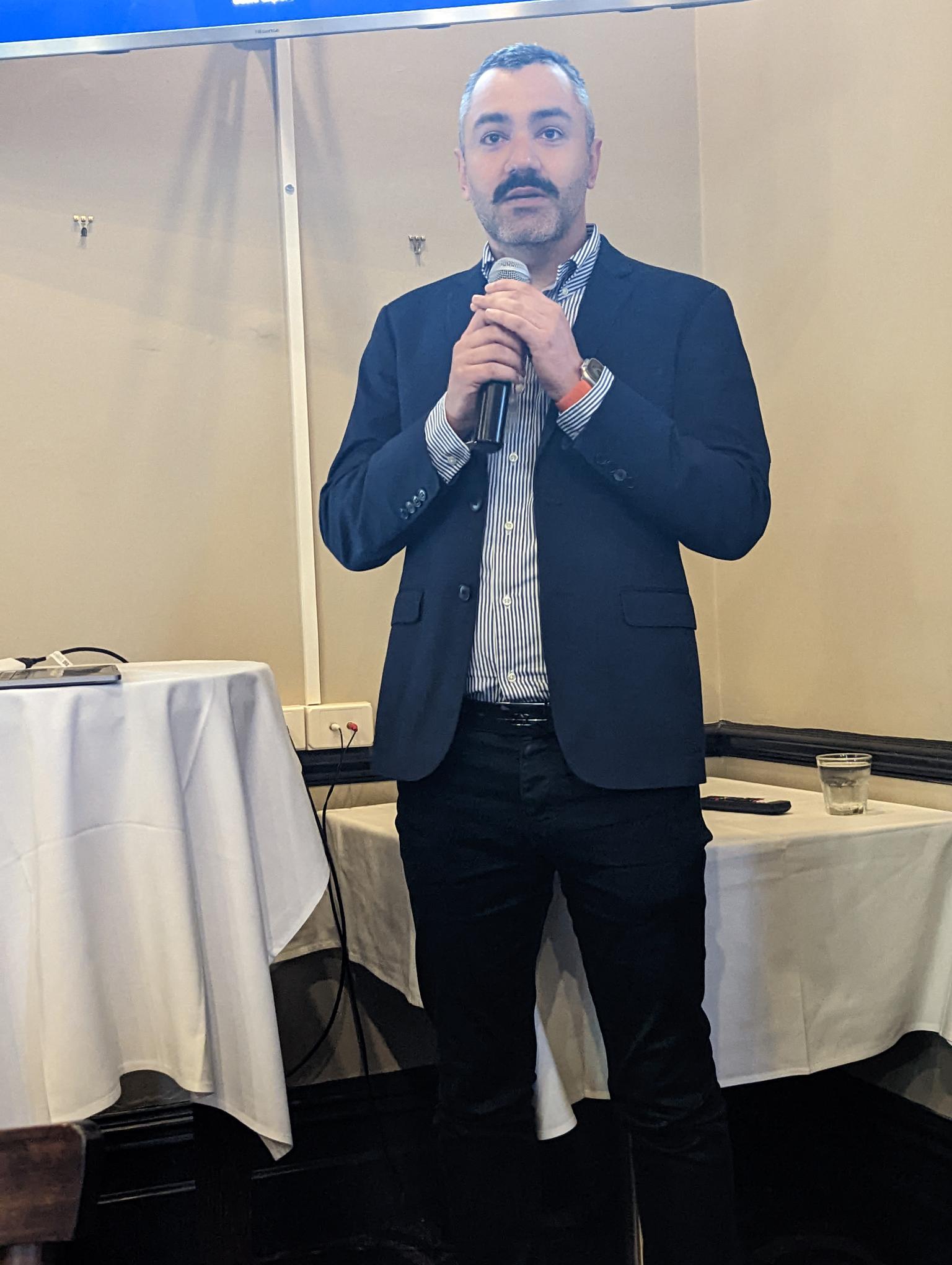
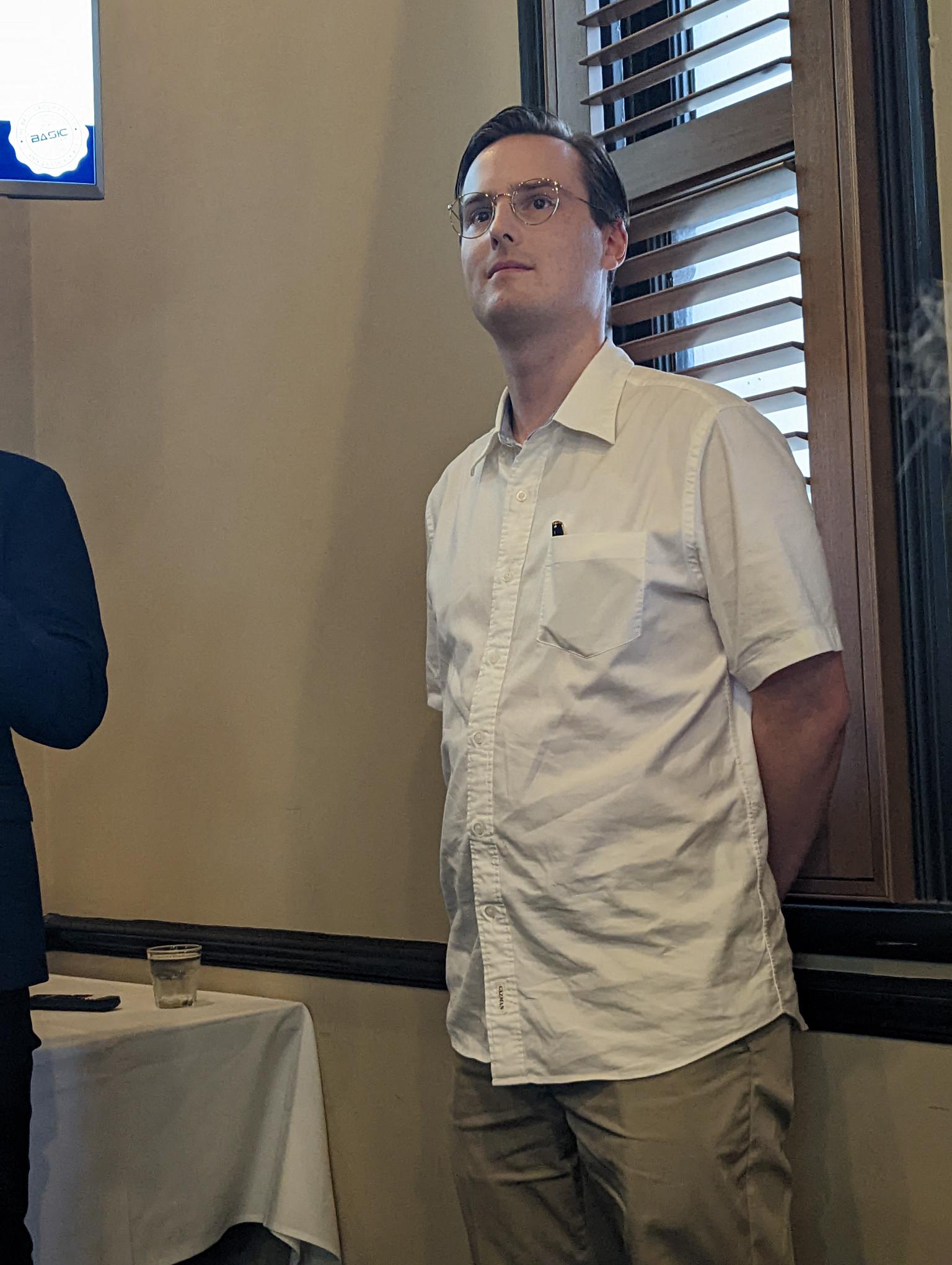
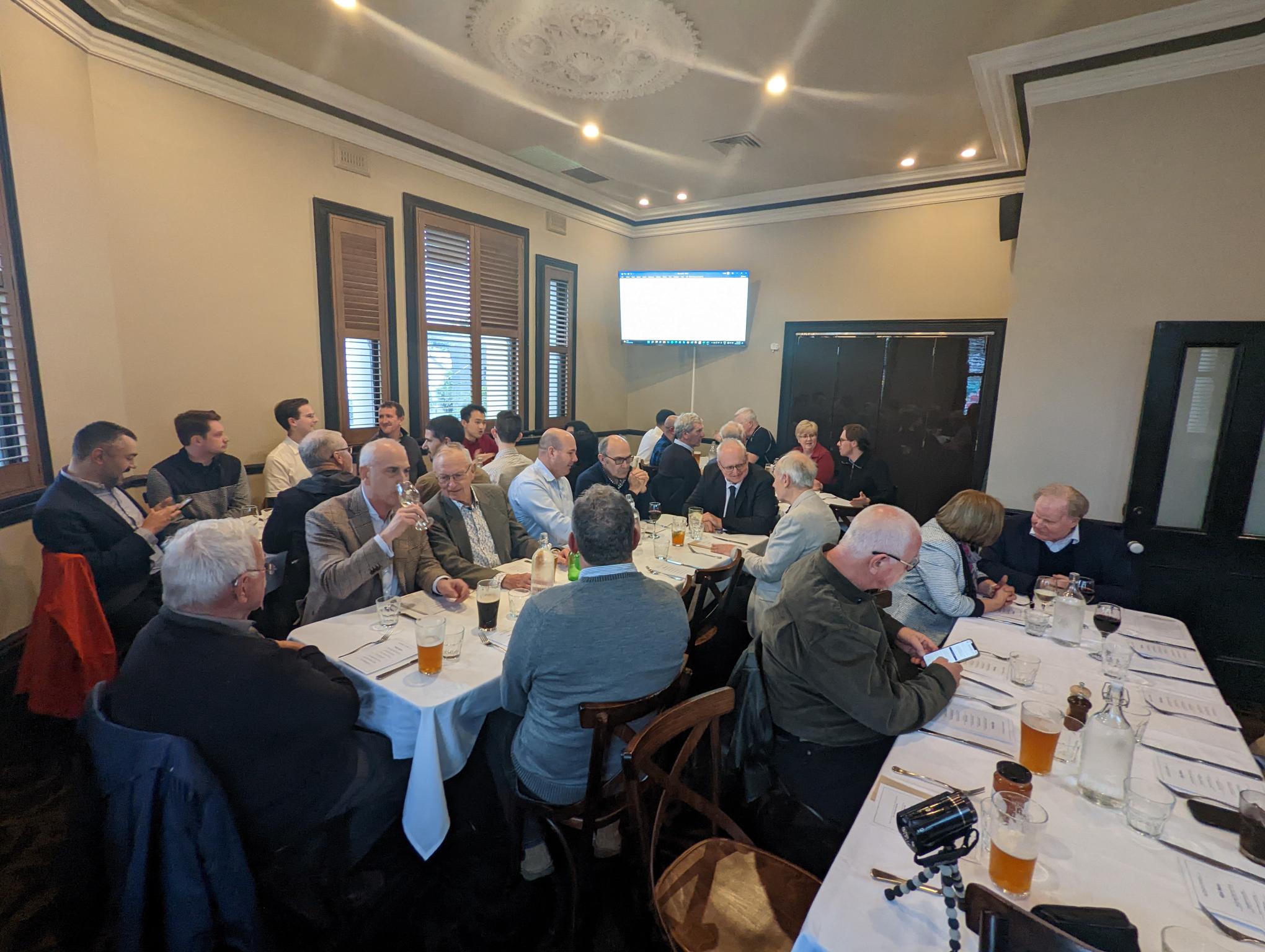
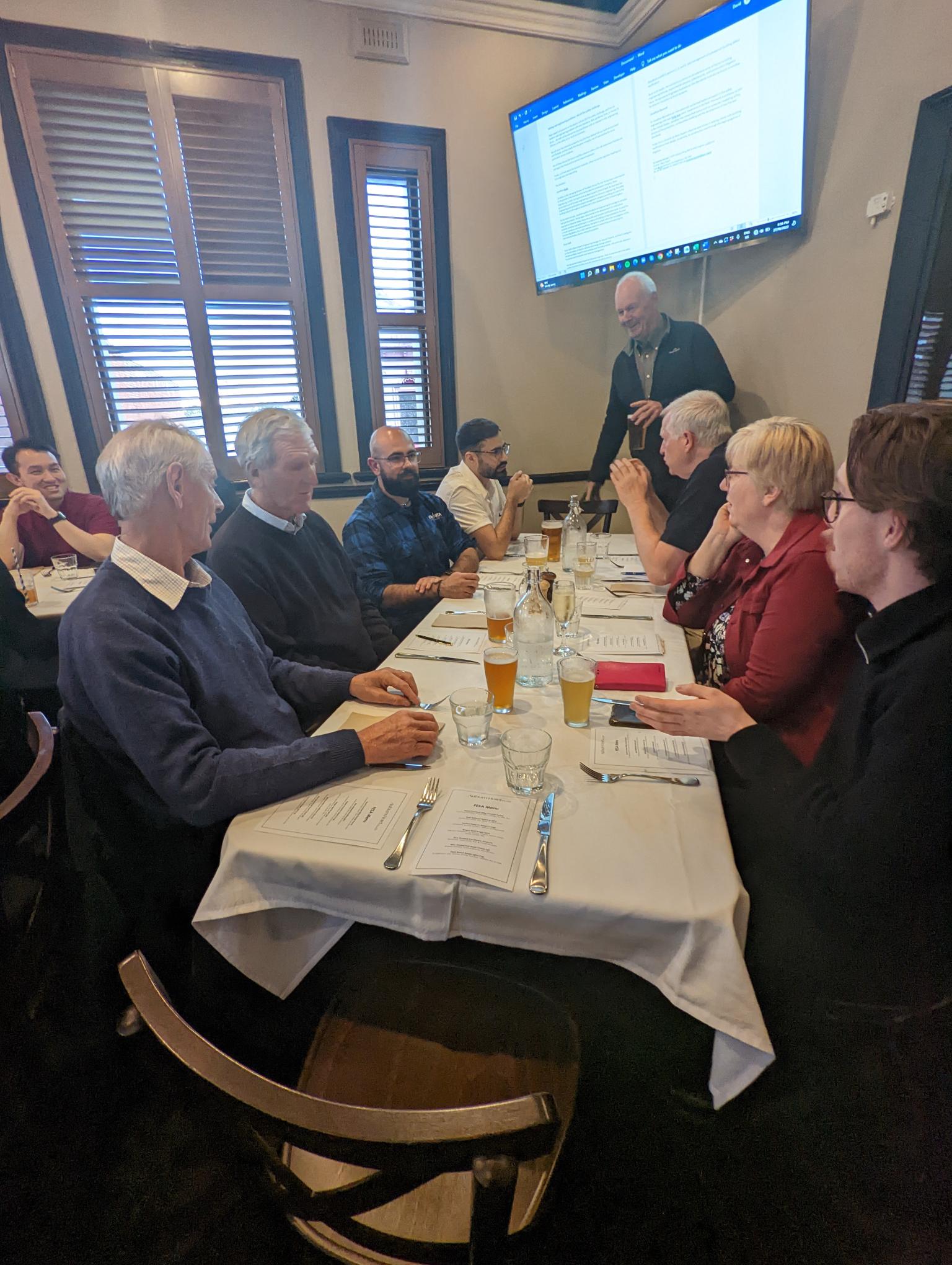

Cyber crime, fraud and forensics
29 September 2022
Jason Conley of Envista Forensics , a forensic examiner since 2003, gave a very interesting presentation on the characteristics of cyber threats and investigation procedures, with examples. Jason's accounts of industrial espionage, intellectual property theft issues, breach of contract and fraud-related investigations dealt with spam, phishing and theft, with tips on risk management. He presented to FESA from London - a great effort in the early hours.
Recordings of the presentation are available here (note the passcode for each)
The presentation: https://us02web.zoom.us/rec/share/ewpqLZtoRUGUGkAZWyfUJpnC7JQlhCQvCdTUoqhkcspIp_ttuaSTtuyK9Qny-Gle.aSx0lcox_2_GX1BP Passcode: m9R2=7K#
Questions and answers: https://us02web.zoom.us/rec/share/TMRmqBT_Vep9SQDJ-JsujoyXgdjbC4OuK_p2nJec8lL8XFe6apmcpBwqE60_JZFZ.eQtYlGmrq5lFtjoy Passcode: e?0^6DY4
Expert Evidence - August 25 2022
An excellent meeting at the Auburn Hotel, Hawthorn, with an outstanding presentation by Justice Jim Delaney (Victorian Supreme Court) on Expert Evidence.
Jim spoke clearly, concisely and authoritatively about all relevant aspects of experts' taking instructions, report writing, hot-tubbing, conclaving, and giving evidence at court. His talk was filled with tips and practical examples. An excellent and lengthy question and answer session followed.


The meeting was very well attended, with extensive networking and introductions. Welcome to all new members!



You can download Jim Delaney's 44 minute presentation here (His Honour preferred not to have the questions section recorded).
-------------------------------------------------------
July 28 2022 (by Zoom): a presentation by Mark Roberts BEng(Hons), MIET, SAE-A on the subject
The Humble 12V Battery - Friend or Foe?
Mark presented on the humble 12V lead-acid AGM battery. Whether you drive a fancy electric vehicle or the traditional internal combustion version, chances are you have owned or had the pleasure of replacing one of these batteries before. But are they more than just a giant AA battery? Mark covered the unique intricacies of 12V AGM batties and, in particular, what transpires when your vehicle's 12V lead-acid battery is pushed beyond its normal operating conditions. As dangerous as its lithium cousin?... there's potential!
Prior to his indoctrination into the forensics engineering industry, Mark functioned as a 12V & 48V Energy Management Engineer within Bentley Motors in the United Kingdom. Responsible for the integration and project management of all 12V Energy Containers and 48V Supercapacitors within Bentley's ICE and PHEV vehicle architectures, Mark spent the majority of his time in Germany and Sweden, prototyping and validating future vehicle projects.
June 23 2022
An excellent dinner meeting at the Auburn Hotel, with 41 attending. Several new people made welcome.



First, FESA member and engineer Tom Dohrmann (a professional mechanical engineer who has worked in automotive design, ergonomics and forensic investigations for sixteen years) spoke on the complexities of converting a new US muscle-ute (the F150, selling here soon) to right hand drive.


Ten minutes with a spanner? Not at all. Tom took us through the fascinating range of new mechanical parts and systems where information sharing was permitted, and described how Ford's methods enhance ride and reliability. Tom is a part of an Australian engineering design team punching above its weight globally. Great to see that the work has created 150 jobs in a brand new new manufacturing facility.
Second, FESA member Peter Paras, a Chartered Professional Engineer with thirty-five years of structural and civil engineering consulting experience, explained his work as a mediator in building disputes.


Peter is an accredited mediator (NMAS), a panel Conciliator at DBDRV (Domestic Building Dispute Resolution Victoria) and a Member of the Building Appeals Board of Victoria, where he carries out conciliations and mediations. He spoke clearly about the concepts and the processes of mediation – how it works, what issues arise, how resolutions are achieved, and the benefit that forensic/expert reports have with disputes at mediation. Vigorous discussion arose, including the obligations of an neutral engineer-mediator when (for example) two parties reach a compromise which the mediator knows is technically flawed.
Both these presentations are being separately recorded, with all their presentation slides, and will be made available to financial memberson the FESA website.
* * * * *
April 28 2022 meeting (at the Auburn Hotel):
Member Geoff Fletcher spoke first to 34 members and guests about the 1907 collapse of the Quebec bridge over the massive St Lawrence river, with 86 lives lost. It collapsed again in 1916. An insight into egos in engineering.
This presentation was very well illustrated, with video and fascinating forensic clues outlined.
You can watch Geoff's presentation (from three minutes in) here:
https://us02web.zoom.us/rec/share/UzYEIWgoSlGqBrDAo-3z3Uxf0BH9pyUwXUpKyNRiHfbiZ8reUnvVZoa9gTwWOYvt.2TEg_dM0h3iGy3cw?startTime=1651136697000 Passcode (required to view): 1?!qP%7T
A second presentation entitled " Who is responsible for the safety of your electrical switchboard and its supply cables?" was by mechatronics engineer Nicholas Jenkins, about a recent argument about who owned the electrical assets in a building. Very interesting issues of liability here.
Nick was standing in for his colleague Peter Hart (regrettably unwell) and did a great job, presenting clearly and dealing capably with questions.
Nicholas' presentation of Peter's material can be viewed in its entirety here:
https://us02web.zoom.us/rec/share/UzYEIWgoSlGqBrDAo-3z3Uxf0BH9pyUwXUpKyNRiHfbiZ8reUnvVZoa9gTwWOYvt.2TEg_dM0h3iGy3cw?startTime=1651138996000 Passcode: 1?!qP%7T
The evening was widely judged a great success, and our Zoom/streaming effort (15 participants) seems to have worked much better.
Our March meeting On 24 March, FESA member Dr Gary Martin MIEAust CPEng CMatP presented to 28 people on Zoom on Acoustic Emissions testing theory and practice. Gary gave a very clear and well illustrated presentation on using the analysis of acoustic emissions (ultrasonic vibrations that arise from plastic deformation, crack growth and corrosion) as an efficient non-destructive test method for many materials. The emissions are picked up by piezoelectric sensors that convert the vibrations to electrical signals that can be processed, classified and interpreted. This technique may be used to predict the likely future failure performance of the test item. This talk introduced us to Acoustic Emission, including the physical basis and its advantages compared to other Non-Destructive Test techniques. The presentation covered the application of Acoustic Emissions monitoring to assessing the structural integrity of Elevating Work Platforms, of pressure vessels, metallic and fibre composites, storage tanks as well electrical transformers. Great illustrations made it all the more clear. Very well received - a topic new to most of us, and closely followed. February meeting We opened the FESA year at the Auburn Hotel, Hawthorn on Thursday 24 February with a full-house dinner, discussion and talk on "Working with lawyers - tips, tricks and traps", presented by engineer Patrick Irwin and lawyer Leslie Schwarz. They took us through several steps of the process, from initial enquiry, appointment, engagement, appearance work, invoicing and payment. Over 40 people made up an enthusiastic audience, with lots of conversations, questions, introductions and networking. Left: Les Schwarz Right: Patrick Irwin We had a crack at streaming the event by Zoom - not very successfully - uncertainties with the microphone, camera and network. Apologies to the patient 14 who logged in - we will improve! |
